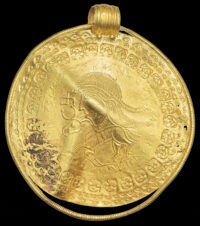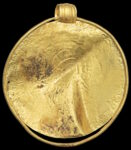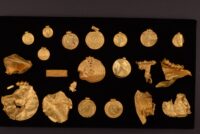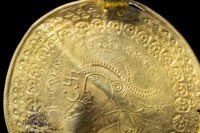 A runic inscription on a gold bracteate discovered near Jelling in 2020 is the oldest known mention of the Norse god Odin. It dates the Norse pantheon back to the beginning of 4th century A.D., 150 years before the previous record-holder, a buckle from the second half of the 5th century discovered in Nordendorf, southern Germany. Before the bracteate was discovered, the oldest inscription to mention Odin ever found in Denmark was on an amulet carved from a piece of human skull dating to the 7th century.
A runic inscription on a gold bracteate discovered near Jelling in 2020 is the oldest known mention of the Norse god Odin. It dates the Norse pantheon back to the beginning of 4th century A.D., 150 years before the previous record-holder, a buckle from the second half of the 5th century discovered in Nordendorf, southern Germany. Before the bracteate was discovered, the oldest inscription to mention Odin ever found in Denmark was on an amulet carved from a piece of human skull dating to the 7th century.
 The bracteate features the profile portrait of a man with a thick braid and a beaded headdress over a horse at gallop. A swastika, often associated with Odin in Norse iconography, and a horseshoe are on the left of the profile. The medallion is bordered by three concentric circles of different decorations rimmed with a tight spiral design. The quality of decoration is exceptionally high. The runes on the bracteate read: “He is Odin’s man.” The “he” in question is unknown, but likely referred to the ruler or king who is depicted on the bracteate. Another word in the inscription reads “Jaga” or “Jagaz” and may be the name or nickname of said Odin’s man.
The bracteate features the profile portrait of a man with a thick braid and a beaded headdress over a horse at gallop. A swastika, often associated with Odin in Norse iconography, and a horseshoe are on the left of the profile. The medallion is bordered by three concentric circles of different decorations rimmed with a tight spiral design. The quality of decoration is exceptionally high. The runes on the bracteate read: “He is Odin’s man.” The “he” in question is unknown, but likely referred to the ruler or king who is depicted on the bracteate. Another word in the inscription reads “Jaga” or “Jagaz” and may be the name or nickname of said Odin’s man.
 The hoard of 22 gold objects discovered by a metal detectorist a field at Vindelev outside of Jelling in South Jutland, is one of the largest and most significant gold hoards ever discovered in Denmark. Except for two Roman gold coins mounted as pendants and one bangle with elaborate gold granulation, the hoard was composed of gold bracteates: round medallions made from thin sheets of gold carved with figures from Norse mythology. Bracteates were worn as pendants by the elite during the Migration Period (375-568 A.D.), but they were typically small pieces the size of pennies. The ones in the Vindelev Hoard are much larger, the size of saucers, and the decoration is of much higher quality than is typically found on bracteates.
The hoard of 22 gold objects discovered by a metal detectorist a field at Vindelev outside of Jelling in South Jutland, is one of the largest and most significant gold hoards ever discovered in Denmark. Except for two Roman gold coins mounted as pendants and one bangle with elaborate gold granulation, the hoard was composed of gold bracteates: round medallions made from thin sheets of gold carved with figures from Norse mythology. Bracteates were worn as pendants by the elite during the Migration Period (375-568 A.D.), but they were typically small pieces the size of pennies. The ones in the Vindelev Hoard are much larger, the size of saucers, and the decoration is of much higher quality than is typically found on bracteates.
 Several of the bracteates had a runic inscriptions, and since the discovery of the hoard was first announced in September 2021, runologists have been working to decipher them. Because of wear and tear on the bracteate, there was significant loss of runes, making interpretation difficult. Even when inscriptions on bracteates have been found intact, they are often single words or garbled copies of copies that have lost their original meanings.
Several of the bracteates had a runic inscriptions, and since the discovery of the hoard was first announced in September 2021, runologists have been working to decipher them. Because of wear and tear on the bracteate, there was significant loss of runes, making interpretation difficult. Even when inscriptions on bracteates have been found intact, they are often single words or garbled copies of copies that have lost their original meanings.
It is the National Museum’s runologist and script researcher Lisbeth Imer who, together with linguist Krister Vasshus, made the discovery.
“The runic inscription has been the most difficult to interpret in my 20 years as a runologist at the National Museum, but the discovery is also absolutely fantastic. It is the first time in world history that Odin’s name is mentioned, and it takes Norse mythology all the way back to the beginning of the 4th century. This makes the Vindelev find even more spectacular. I have not seen such well-executed runes and such a long text on a Danish find from this period since the golden horns [i.e., the Golden Horns of Gallehus]. It may become a key to understanding other prehistoric runic inscriptions that we have not been able to read so far, ” says Lisbeth Imer. […]
Apart from runic inscriptions, we have no written sources from Denmark in the fourth century, so we do not know much about who this “Odin’s man” and “Jaga” or “Jagaz” are, but everything points to him being very important in 400s. The amount of gold in the Vindelev find is enormous, and the gold bracteates are both much larger and thicker than corresponding bracteates. They were probably worn in some form of mayor’s chain, which emphasized the wearer’s status.
The gold is imported from the south, and the bracteates are also modeled after the Romans, suggesting a strong network down through Europe. The king had contact with many other parts of both Denmark and Europe, because similar or stamp-identical bracts have been found both on Funen, in North Jutland, West Jutland and in northern Germany – not to mention the emperor’s medallions, which have also been found in Vindelev. They have parallels as far away as central Germany and Poland.